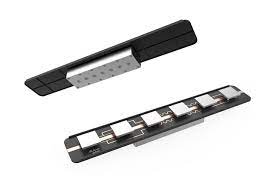This new product addresses the growing trend toward smaller, lighter 5G macro cells by providing a possible replacement for metal. For example, ULTEM™ 3473 resin can help reduce the weight of an aluminum radio frequency (RF) cavity filter by up to 40 percent.
In a typical macro cell with 64 filters, this weight saving can be significant. Furthermore, this new resin can help facilitate the design of new, integrated antenna filter units (AFUs), which is not achievable with metal. Using injection molding, the dipole antenna matrix and RF cavity filter body can be produced as one piece. This approach simplifies production and may lead to additional weight savings and system cost reductions.
"During the close collaboration with the industry’s leading companies, we have witnessed a growing number of 5G infrastructure manufacturers validating the use of lighter materials to make it easier and faster to assemble, transport, and install these components," said David Wang, senior business manager, SABIC. “By offering an effective alternative to metal and helping enable the design of integrated antenna filter units, we aim to help them achieve these goals."
New ULTEM™ 3473 resin offers performance, processing, and assembly advantages over die-cast metal and thermoplastics such as filled polyphenylene sulfide (PPS). The new SMT-capable resin enables components to withstand very high temperatures, up to 260°C, during the assembly process.
Metal-like Dimensional Stability
With a coefficient of thermal expansion (CTE) similar to that of metal, ULTEM™ 3473 resin provides dimensional stability under a wide range of operational temperatures, from -40°C to 150°C, over the long term. Dimensional stability of the material, in turn, helps ensure consistent signal filtering of the RF cavity filter by minimizing dimensional variations over these temperature ranges. In contrast, the CTE of filled PPS products increases significantly at temperatures above 85°C to 90°C, according to SABIC internal testing.
Apart from ULTEM™ 3473 resin’s advantages of low CTE and SMT capability, it provides excellent surface metallization performance during the chemical plating process. The result is good adhesion of the metal layer to the matrix, with low surface roughness. These factors help ensure low signal loss and long-term reliability.
Customers that opt for new integrated AFU designs made with ULTEM™ 3473 resin can significantly reduce cycle times compared to casting and machining aluminum. Injection molding of multiple one-piece components can help manufacturers increase throughput, respond more rapidly to the growing demand for 5G components, and potentially reduce the additional weight and system cost of 5G macro cells.
Source:SABIC





No comments:
Post a Comment